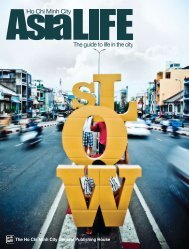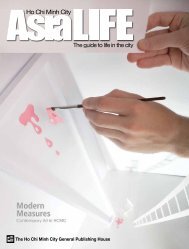Brett Davis - AsiaLIFE Magazine
Brett Davis - AsiaLIFE Magazine
Brett Davis - AsiaLIFE Magazine
Create successful ePaper yourself
Turn your PDF publications into a flip-book with our unique Google optimized e-Paper software.
Po Shanu Tower<br />
The Brick Builders<br />
Po Adam-Hung<br />
Last Cham Kings Crown<br />
Hindus believed that their deities resided on Mount<br />
Meru, in the centre of the universe. Champa, like other<br />
Hinduized cultures, built their temples as mini replicas of<br />
this abode. Eastward-facing Cham temples were usually<br />
built on mounds or hilltops overlooking moving water.<br />
Much like earlier Funan temples, but unlike Angkor<br />
monuments, Cham towers were constructed entirely of<br />
red bricks. Mortar isn’t visible on the outside of a Cham<br />
temple. This gave rise to stories by the Vietnamese that<br />
the bricks were only air-dried before set in place, and then<br />
covered with a resin before the entire tower was baked<br />
in situ by a giant bonfire. In reality, a loose mortar can be<br />
found between inner brick layers. Further, ancient kilns<br />
where the bricks were baked prior to temple construction<br />
have been found outside Phan Thiet.<br />
The remaining artefacts have been<br />
ravaged so aggressively in the last<br />
20 years that there will soon be<br />
nothing left worth saving if they<br />
are not immediately placed under<br />
protection.<br />
With several temple ruin sites<br />
recently discovered—ranking<br />
among the oldest—it seems that<br />
Binh Thuan Province may have<br />
been the birthplace of classical<br />
Cham architecture, likely influenced<br />
by the neighbouring and<br />
elder Funan Empire.<br />
Unfortunately the remaining<br />
artefacts have been ravaged so<br />
aggressively in the last 20 years,<br />
by both professional temple<br />
robbers and local farmers, that<br />
there will soon be nothing left<br />
worth saving if they are not<br />
immediately placed under<br />
protection.<br />
Cham temples often served as<br />
tombs for the kings of Champa,<br />
and the Cham were notorious<br />
for hiding gold and jewellery<br />
under tower foundations,<br />
as offerings to the god-kings<br />
buried there. This has always<br />
made them a target of choice<br />
for robbers, who also carry off<br />
valuable statuary, lingas (phallic<br />
representations of Shiva)<br />
and steles bearing the written<br />
history of the king to which the<br />
temple was devoted. Tomb raiders<br />
(and farmers demolishing<br />
temple ruins to clear land for<br />
crops) may have done nearly as<br />
much damage to the sum total<br />
of Champa’s relics in the last 20<br />
years as all of America’s bombs<br />
at My Son.<br />
At the moment, no one is paying<br />
attention. “We don’t really<br />
care about the collapsed Cham<br />
ruins far in the countryside”<br />
an assistant at the Ministry of<br />
Tourism told me. “The country<br />
just restores and protects the<br />
big beautiful temples near the<br />
highway—the ones that tourist<br />
like and are easy to access.”<br />
ing the earliest days of Champa,<br />
but that it may in fact be the<br />
earliest seed of Cham culture in<br />
Vietnam.<br />
Panduranga Revisited<br />
Until recently, the only known<br />
Cham towers in Binh Thuan<br />
Province were Po Shanu in Phan<br />
Thiet, and little-known Po Dam<br />
near Phan Ri. Po Shanu is the<br />
oldest known Cham tower, yet<br />
it’s often overlooked in age-style<br />
comparisons between towers<br />
because it inconveniently looks<br />
as much like a pre-Angkorian<br />
Khmer temple of the Funan<br />
Kingdom as a Cham temple. Po<br />
Dam, only thought to be a little<br />
older, is similar in style to Tha<br />
Hoa Lai in Phan Rang. Interestingly,<br />
Hoa Lai has long been<br />
disowned by the Cham, who<br />
claim it is a Khmer (Angkorian<br />
or Funan-era) temple.<br />
Last summer Phan Thiet’s<br />
provincial museum made a<br />
small announcement about<br />
a 9th century temple ruin<br />
discovered in the far north of<br />
the province, on the road to<br />
Dalat. As usual the nearest<br />
stated village didn’t appear on<br />
any map, so I set out with my<br />
friend Hung to find it, again<br />
by asking locals. In the process<br />
of my search I would accidentally<br />
find two undocumented<br />
temples. Then after finding<br />
the government’s temple, I<br />
located the fourth, “Reservoir<br />
Tower” described previously.<br />
Strangely, only two of these<br />
four temple sites are in view of<br />
running water, and none are on<br />
pronounced hilltops. If the locations<br />
were forested at the time<br />
of construction, no view of the<br />
countryside would have been<br />
afforded. This is very unusual<br />
for Cham temples anywhere in<br />
Vietnam, except for the holy city<br />
of My Son.<br />
The first temple that I found<br />
I named Po Adam-Hung in jest.<br />
The main tower shaft, with tall,<br />
smooth walls, penetrated down<br />
into the centre of a mound. It<br />
seems as though the temple roof<br />
collapsed outward and formed<br />
the mound around it. Beside it<br />
is a smaller building, still apparently<br />
intact but buried in the<br />
mound. Along it is a trench and<br />
another wall, as though forming<br />
a hallway.<br />
The second undocumented<br />
temple site, which I tentatively<br />
named “The Farmer’s Tower”<br />
(it sits in the middle of cropland),<br />
is about a 15-minute drive<br />
away. It consists of multiple<br />
structures, all entirely collapsed<br />
but one. Three outer walls remain,<br />
hidden by trees and vines.<br />
Bricks and an undecorated lintel<br />
lay strewn upon the ground.<br />
The third set of ruins, announced<br />
and excavated by the<br />
government, is all but collapsed,<br />
save the foundation, and questionably<br />
dated by authorities<br />
as 9th-century. This temple is<br />
about 20 minutes drive north<br />
from the others, at the foot of<br />
the mountains.<br />
These ruins, together with Po<br />
Shanu and yet another badly<br />
degraded ruin on the edge of<br />
Phan Thiet, all lay within Binh<br />
Thuan’s central Quao River<br />
Delta. I don’t believe that it<br />
is a coincidence that these,<br />
Champa’s oldest known towers,<br />
are in such close proximity to<br />
the elder Funan ruins in Cat<br />
Tien National Park. I believe<br />
that Binh Thuan’s ruins may<br />
represent a transition between<br />
the Funan and Cham architectural<br />
styles, and that there are<br />
probably many other vestiges<br />
here with transitional styles that<br />
are yet to be discovered.<br />
In addition to these seven<br />
towers, sources have confirmed<br />
the existence of at least 10 more<br />
ancient Cham temple sites in the<br />
province, as well as numerous<br />
shrines and the ancient Cham<br />
citadel of Song Luy. Among<br />
these are the newly discovered<br />
temple sites in the districts of<br />
Muong Man and Binh Tan,<br />
which display remarkable<br />
similarities in size, complexity<br />
and sophistication to principal<br />
temples in the holy city My<br />
Son. All of these temples are<br />
loosely dated from the 8th to 9th<br />
centuries.<br />
Champa’s History at a Precipice<br />
From these discoveries, I<br />
conclude that Panduranga was<br />
much more actively settled<br />
in the early days of Champa<br />
than previously thought. "The<br />
riparian Cham cities of Phan<br />
Thiet and Phan Ri both have<br />
Cham and Sa Huynh relics in<br />
the vicinity that suggests they<br />
may be among the oldest and<br />
longest-continuously inhabited<br />
cities in Vietnam (2,500 years)."<br />
Another quality development by<br />
Asia Life August 2010.indd 1 23/08/2010 05:02:15<br />
36 asialife HCMC asialife HCMC 37















